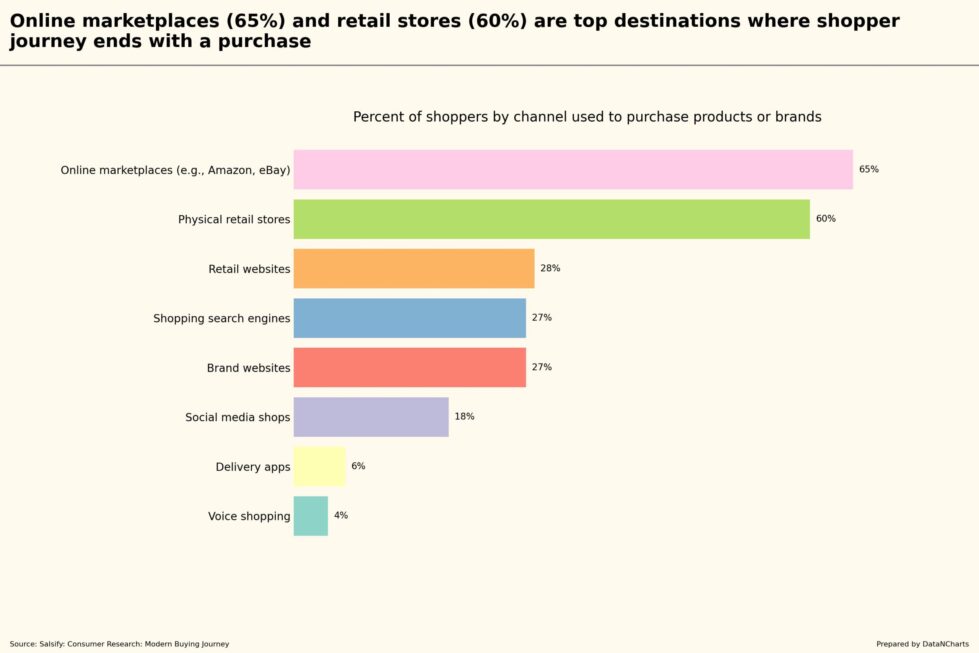Data Highlights
Nearly two-thirds (65%) of shoppers buy through online marketplaces.
Six in ten (60%) complete purchases in physical retail stores.
About one-quarter use retail websites (28%), shopping search engines (27%), or brand websites (27%) to buy products.
A negligible share shops via social media (18%), delivery apps (6%), or voice-enabled shopping (9%).
Scope
Understanding where shoppers finalize purchases guides brands to optimize retail strategies effectively. As e-commerce trends accelerate, brands face increased pressure to integrate online and physical shopping experiences seamlessly. This brief explores the channels shoppers prefer for final purchases. Readers gain consumer behavior insights to refine shopper marketing strategies and improve customer experience optimization efforts.
Online Marketplaces Lead Shopper Preferences (65%)
Most shoppers (65%) prefer online marketplaces, trusting platforms like Amazon and eBay. Marketplaces offer broad selections, clear pricing, and quick shipping. Retailers must maintain optimized product listings here to capture shoppers. Clearly organized product pages and purchase intent keywords effectively influence marketplace shoppers.
Yet, physical retail remains critical for many consumers.
Physical Stores Still Key for Final Purchases (60%)
Six in ten shoppers (60%) choose physical retail stores for final purchases. Physical stores let shoppers interact with products directly. Retailers optimizing in-store shopper behavior through effective layouts and engaging experiences clearly increase conversions. Combining digital content and physical retailtainment strongly appeals to these shoppers.
Meanwhile, a meaningful share of shoppers prefers retailer-controlled websites.
Retail, Brand, and Search Sites Offer Strategic Opportunities (27–28%)
About one-quarter buy directly from retail websites (28%), brand websites (27%), or shopping search engines (27%). These channels let retailers control customer experience optimization closely. Brands clearly providing user-friendly navigation, detailed product information, and easy checkout can improve conversions significantly.
Other digital channels attract fewer final purchases but remain noteworthy.
Social Media, Delivery Apps, and Voice Shopping Remain Limited (18%, 6%, 9%)
A negligible share shops via social media platforms (18%), delivery apps (6%), or voice-enabled shopping (9%). These emerging e-commerce trends attract niche shopper segments. Retailers investing here can capture early adopters, although impact remains limited for most shoppers.
Insights and Opportunities
Shopper behavior data clearly highlights opportunities for retailers and brands to optimize shopping channels, content, and shopper experiences.
- Firstly, brands must prioritize online marketplace presence and physical store integration. Optimizing marketplace listings and integrating clear online-to-store experiences increases conversions, improves shopper satisfaction, and grows sales. Expect higher conversions, increased repeat purchases, and stronger brand loyalty. KPIs include conversion rates, customer retention, and customer satisfaction scores.
- Secondly, retailers should optimize their own digital channels. Clear product content, easy navigation, and simple checkout processes attract more shoppers and boost conversions. Brands can expect increased direct sales, higher average order values, and reduced bounce rates. Track effectiveness using KPIs like site conversion rates, average transaction values, and cart abandonment rates.
- Finally, invest selectively in emerging channels like social media and voice-enabled shopping. Clear content and engaging experiences here can position brands favorably with younger shoppers and tech-savvy buyers. Retailers can expect early-mover brand recognition, increased digital consumer engagement, and eventual sales growth among targeted segments. Evaluate success through engagement rates, channel-specific conversions, and brand awareness metrics.
Aligning channel strategies clearly with shopper preferences enhances the shopper path to purchase, driving improved sales performance and deeper consumer loyalty.
